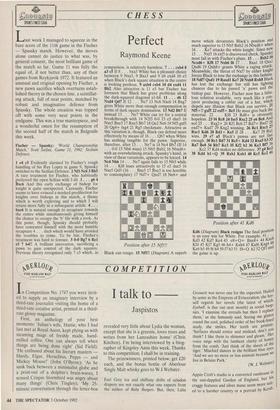CHESS
Perfect
Raymond Keene
Last week I managed to squeeze in the bare score of the 11th game in the Fischer — Spassky match. However, the moves alone cannot do justice to what was, by general consent, the most brilliant game of the match so far. Game 11 was fully the equal of, if not better than, any of their games from Reykjavik 1972. It featured an unusual and original opening by Fischer, a new pawn sacrifice which overturns estab- lished theory in the chosen line, a scintillat- ing attack, full of neat points, matched by robust and imaginative defence from Spassky. The whole creation was topped off with some very neat points in the endgame. This was a true masterpiece, and a wonderful omen for the resumption of the second half of the match in Belgrade this week.
Fischer — Spassky: 'World Championship Match,' Sveti Stefan, Game 11, 1992: Sicilian Defence.
1 e4 c5 Evidently alarmed by Fischer's rough handling of his Ruy Lopez in game 9, Spassky switches to the Sicilian Defence. 2 Nf3 Nc6 3 Bb5 A rare treatment for Fischer, who habitually preferred the open Scilian with 3 d4. 3 . . . g6 4 Bxc6 And this early exchange of bishop for knight is quite unexpected. Curiously, Fischer seems to have evinced a marked predilection for knights over bishops in this match, a theme which is worth exploring and to which I will return more fully in a subsequent article. 4 . . . bxc6 It is natural enough to recapture towards the centre while simultaneously giving himself the chance to occupy the 'b' file with a rook. At this point, though, Spassky should probably have contented himself with the more humble recapture 4 . . . dxc6 which would have avoided the troubles to come. To be fair, Fischer's treatment was hard to foresee. 5 0-0 Bg7 6 Rel e5 7 b4!! A brilliant innovation, sacrificing a pawn to gain control of the dark squares. Previous theory recognised only 7 c3 which, in comparison, is relatively harmless. 7 . . . cxb4 8 a3 c5 If 8 . . . bxa3 White has a pleasant choice between 9 Nxa3, 9 Bxa3 and 9 d4 exd4 10 e5 when Black's dark square situation in the centre is looking perilous. 9 axb4 cxb4 10 d4 exd4 11 Bb2 Also attractive is 11 e5 but Fischer has foreseen that Black has grave problems along the dark-squared diagonal al-h8. 11 . . . d6 12 Nxd4 Qd7 If 12 . . . Ne7 13 Nc6 Nxc6 14 Bxg7 gives White more than enough compensation in terms of dark square domination. 13 Nd2 Bb7 If instead 13 . . . Ne7 White can try for a central breakthrough with 14 N2f3 0-0 15 e5 dxe5 16 NxeS Bxe5 17 Rxe5 Bb7 18 Qe2 Nc6 19 Nf5 gxf5 20 Qg4+ fxg4 21 Rg5 checkmate. Attractive as this variation is, though, Black can defend more effectively by means of 16 . . . Qb7 when White has nothing tangible for the pawn. Superior, therefore, after 13 . . . Ne7 is 14 Nc4 Bb7 (If 14 . . . 0-0 15 Nb6 wins) 15 Nb5 Bxb2 16 Nbxd6+ with an overwhelming attack. Spassky's hand, in view of these variations, appears to be forced. 14 Nc4 Nh6 14 . . . Ne7 again fails to 15 Nb5 while 14 . . . Kf8 loses attractively to 15 e5 dxe5 16 NxeS Qd5 (16 . . . Bxe5 17 RxeS is too horrible to contemplate) 17 Nd7+ Qxd7 18 Ne6+ and Position after 15 Nf5!!
Black can resign. 15 Nf5!! (Diagram) A superb move which devastates Black's position and much superior to 15 Nb5 Bxb2 16 Nbxd6+ when 16 . . . Ke7 attacks the white knight. Since now 15 . . . NxfS 16 exf5 is discovered check, Spassky must fall in with Fischer's plans. 15 . . . Bxb2 16 Ncxd6+ Kf8 17 Nxh6 f6 17 . . . Bxal 18 Qxal Qxd6 19 Qxh8+ grants White a raging attack. Meanwhile, the threat of Nxf7 by either knight forces Black to lose the exchange in this fashion. 18 Ndf7 Qxdl 19 Raxdl Ke7 20 NxhS RxhS Black has lost the exchange but still has fighting chances due to his passed 'a' pawn and the bishop pair. However, Fischer now has a fabu- lous solution available, very much like a con- juror producing a rabbit out of a hat, which dispels any illusion that Black can survive. 21 Nf5+!! gxf5 22 exf5+ Bey He must give back the material. 22 . . . Kf8 23 Rd8+ is obviously hopeless. 23 f4 Rc8 24 fxe5 Rxc2 25 e6 Bc6 And not 25 . . . Rxg2+ 26 Kfl Bc6 27 Rd7+ Bxd7 28 exd7+ Kxd7 29 Kxg2 winning. 26 Rcl Rxcl 27 Rxcl Kd6 28 Rdl + Ke5 If 28 . . . Ke7 29 Ral wins. 29 e7 a5 Black's pawns are not fast enough. 30 Rcl Bd7 31 RcS+ Kd4 32 Rxa5 b3 33 Raj Be8 34 Rb7 Kc3 35 Kf2 b2 36 Ke3 Bf7 36 . . . Kc2 37 Kd4 makes no difference. 37 g4 Kc2 38 Kd4 b1 =Q 39 Rxbl Kxbl 40 Kc5 Kc2 41
Position after 41 Kd6
Kd6 (Diagram) Black resigns The final position is an easy win for White. For example, 41 . • Kd3 42 Kd7 Ke4 43 e8=Q+ Bxe8+ 44 ICxeo Kf4 45 Kf7 Kg5 46 h4+ Kxh4 47 Kxf6 IC/4 48 Ke6 h5 49 f6 h4 50 f7 h3 51 f8=Q h2 52 Qf and the game is up.


















































 Previous page
Previous page